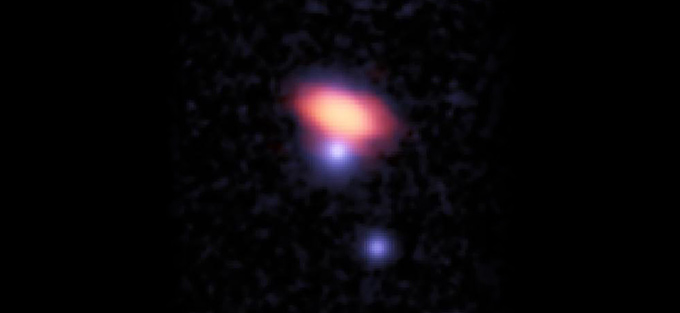ALMA Uses ‘Double Vision’ to Study Galaxy’s Gaseous Ingredients
Researchers using the Atacama Large Millimeter/submillimeter Array (ALMA) combined two techniques for the first time to achieve the most comprehensive study to date of molecular gas in a galaxy. They observed the emission of the very nearby galaxy PKS0439_008_04 and, at the same time, the absorption of a far quasar on a direct line of sight with the galaxy.
Astronomers usually study molecular gas —the fuel for star formation— using one of two methods: either by investigating a galaxy’s “emission” or its “absorption.” The former technique involves looking at the natural radio emission from the gas that permeates the galaxy and its expansive halo. The latter method examines the light from more distant objects, like a bright quasar, that gets absorbed as it passes through the galaxy.
This work constitutes the most comprehensive study of molecular gas in a galaxy to date. “Previously, quasar absorption studies ‘blinded’ telescopes to the less intense and much more diffuse emission signal from the galaxy,” said Marcel Neeleman, with the University of California’s Lick Observatory and lead author on a paper published in Astrophysical Journal Letters. In this study, astronomers were able to directly detect the faint emission signal from carbon monoxide in the galaxy.
By comparing this emission to the absorption signal from the quasar, the researchers found that the strongest absorption did not occur in the disk of the galaxy. Instead, most of the quasar’s light was absorbed by the diffuse gas surrounding the galaxy—gas that would be nearly impossible to detect through other means.
The astronomers’ results suggest that far from the galaxy, there is a significant amount of molecular gas that is not actually part of the galaxy, but bound to it. “We may be witnessing the recycling of material that, in a few billion years, will again trigger a burst of star formation,” concluded Neeleman.
The nearby galaxy, known as PKS0439_008_04, is approximately 1.4 billion light-years from Earth. The more distant quasar, PKS0439-433, is approximately 7.3 billion light-years from Earth. Both are in the direction of the constellation Caelum.

Composite ALMA and optical image showing glowing emission from carbon monoxide (red) in galaxy PKS0439_008_04. The more distant quasar, PKS0439-433 (central blue feature), revealed through absorption in the visible spectrum the presence of an extended, diffuse halo of molecular gas surrounding the galaxy. The optical data are from the Irénée du Pont Telescope at the Las Campanas Observatory. Credit: Neeleman et al.; ALMA (ESO/NAOJ/NRAO); B. Saxton (NRAO/AUI/NSF); H.-W. Chen, Carnegie Observatories. | Download image
Additional information
These observation results were published as Neeleman et al. “First Connection between Cold Gas in Emission and Absorption: CO Emission from a Galaxy-Quasar Pair,” in the Astrophysical Journal of Letters, April 2016. (Preprint: https://arxiv.org/abs/1604.05720).
The team is composed of Marcel Neeleman [1], J. Xavier Prochaska [1], Martin A. Zwaan [2], Nissim Kanekar [3], Lise Christensen [4], Miroslava Dessauges-Zavadsky [5], Johan P.U. Fynbo [4], Eelco van Kampen [2], Palle Møller [2] and Tayyaba Zafar [6].
[1] Department of Astronomy & Astrophysics, UCO/Lick Ob- servatory, University of California, Santa Cruz, USA.
[2] European Southern Observatory, Garching bei München, Germany.
[3] Swarnajayanti Fellow; National Centre for Radio Astrophysics, Tata Institute of Fundamental Research, Pune, India.
[4] Dark Cosmology Centre, Niels Bohr Institute, University of Copenhagen, Copenhagen, Denmark.
[5] Observatoire de Genève, Université de Genève, Sauverny, Switzerland.
[6] Australian Astronomical Observatory, North Ryde, Australia.
The Atacama Large Millimeter/submillimeter Array (ALMA), an international astronomy facility, is a partnership of the European Organisation for Astronomical Research in the Southern Hemisphere (ESO), the U.S. National Science Foundation (NSF) and the National Institutes of Natural Sciences (NINS) of Japan in cooperation with the Republic of Chile. ALMA is funded by ESO on behalf of its Member States, by NSF in cooperation with the National Research Council of Canada (NRC) and the Ministry of Science and Technology (MOST) in Taiwan and by NINS in cooperation with the Academia Sinica (AS) in Taiwan and the Korea Astronomy and Space Science Institute (KASI).
ALMA construction and operations are led by ESO on behalf of its Member States; by the National Radio Astronomy Observatory (NRAO), managed by Associated Universities, Inc. (AUI), on behalf of North America; and by the National Astronomical Observatory of Japan (NAOJ) on behalf of East Asia. The Joint ALMA Observatory (JAO) provides the unified leadership and management of the construction, commissioning and operation of ALMA.
Contacts
Nicolás Lira T.
Education and Public Outreach Coordinator
Joint ALMA Observatory
Santiago, Chile
Tel: +56 2 24 67 65 19
Cell: +56 9 94 45 77 26
Email: [email protected]
Charles E. Blue
Public Information Officer
National Radio Astronomy Observatory
Charlottesville, Virginia, USA
Tel: +1 434 296 0314
Cell: +1 202 236 6324
E-mail: [email protected]
Richard Hook
Public Information Officer, ESO
Garching bei München, Germany
Tel: +49 89 3200 6655
Cell: +49 151 1537 3591
Email: [email protected]
Masaaki Hiramatsu
Education and Public Outreach Officer, NAOJ Chile
Observatory
Tokyo, Japan
Tel: +81 422 34 3630
E-mail: [email protected]
Contacts
-
Nicolás Lira
Education and Public Outreach CoordinatorJoint ALMA Observatory, Santiago - ChilePhone: +56 2 2467 6519Cel: +56 9 9445 7726Email: [email protected] -
Charles E. Blue
Public Information OfficerNational Radio Astronomy Observatory Charlottesville, Virginia - USAPhone: +1 434 296 0314Cel: +1 202 236 6324Email: [email protected] -
Richard Hook
Public Information Officer, ESOGarching bei München, GermanyPhone: +49 89 3200 6655Cel: +49 151 1537 3591Email: [email protected] -
Masaaki Hiramatsu
Education and Public Outreach Officer, NAOJ Chile

